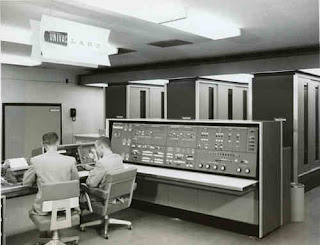Five Generations of Computers.
First
Generation of Computers (1942-1955)
The beginning of commercial
computer age is fromUNIVAC (Universal
Automatic Computer). It was developed by two scientists Mauchly and Echert at the Census
Department of United States in 1947.The first generation computers
were used during 1942-1955. They were based on vacuum tubes. Examples of first generation computers are ENIVACand UNIVAC-1.
Advantages
·
Vacuum
tubes were the only electronic component available during those days.
·
Vacuum
tube technology made possible to make electronic digital computers.
·
These
computers could calculate data in millisecond.
Disadvantages
·
The
computers were very large in size.
·
They
consumed a large amount of energy.
·
They
heated very soon due to thousands of vacuum tubes.
·
They
were not very reliable.
·
Air
conditioning was required.
·
Constant
maintenance was required.
·
Non-portable.
·
Costly
commercial production.
·
Limited
commercial use.
·
Very
slow speed.
·
Limited
programming capabilities.
·
Used
machine language only.
·
Used
magnetic drums which provide very less data storage.
·
Used
punch cards for input.
·
Not
versatile and very faulty.\
Second
Generation Computers (1955-1964)
The second
generation computers used transistors.
The scientists at Bell laboratories developed transistor in 1947. These
scientists include John Barden, William Brattain and William Shockley. The size
of the computers was decreased by replacing vacuum tubes with transistors. The
examples of second generation computers are IBM 7094 series, IBM
1400 series and CDC 164 etc.
Advantages
·
Smaller
in size as compared to the first generation computers.
·
The
2nd generation Computers were more reliable
·
Used
less energy and were not heated.
·
Wider
commercial use
·
Better
portability as compared to the first generation computers.
·
Better
speed and could calculate data in microseconds
·
Used
faster peripherals like tape drives, magnetic disks, printer etc.
·
Used
Assembly language instead of Machine language.
·
Accuracy
improved.
Disadvantages
·
Cooling
system was required
·
Constant
maintenance was required
·
Commercial
production was difficult
·
Only
used for specific purposes
·
Costly
and not versatile
·
Puch
cards were used for input.
Third
Generation Computers (1964-1975)
The Third
generation computers used the integrated circuits (IC). Jack Kilby developed the concept of
integrated circuit in 1958. It was an important invention in the computer
field. The first IC was invented and used in 1961. The size of an IC is about ¼
square inch. A single IC chip may contain thousands of transistors. The
computer became smaller in size, faster, more reliable and less expensive. The
examples of third generation computers are IBM 370, IBM
System/360,UNIVAC 1108 and UNIVAC AC 9000 etc.
Advantages
·
Smaller
in size as compared to previous generations.
·
More
reliable.
·
Used
less energy
·
Produced
less heat as compared to the previous two generations of computers.
·
Better
speed and could calculate data in nanoseconds.
·
Used
fan for heat discharge to prevent damage.
·
Maintenance
cost was low because hardware failure is reare.
·
Totally
general purpose
·
Could
be used for high-level languages.
·
Good
storage
·
Versatile
to an extent
·
Less
expensive
·
Better
accuracy
·
Commercial
production increased.
·
Used
mouse and keyboard for input.
Disadvantages
·
Air
conditioning was required.
·
Highly
sophisticated technology required for the manufacturing of IC chips.
Fourth
Generation Computers (1975-Present)
The
fourth generation computers started with the invention of Microprocessor. The
Microprocessor contains thousands of ICs. Ted Hoff produced
the first microprocessor in 1971 for Intel. It was known as
Intel 4004. The technology of integrated circuits improved rapidly. The LSI
(Large Scale Integration) circuit and VLSI (Very Large Scale Integration)
circuit was designed. It greatly reduced the size of computer. The size of
modern Microprocessors is usually one square inch. It can contain millions of
electronic circuits. The examples of fourth generation computers are Apple
Macintosh & IBM PC.
Advantages
·
More
powerful and reliable than previous generations.
·
Small
in size
·
Fast
processing power with less power consumption
·
Fan
for heat discharging and thus to keep cold.
·
No
air conditioning required.
·
Totally
general purpose
·
Commercial
production
·
Less
need of repair.
·
Cheapest
among all generations
·
All
types of High level languages can be used in this type of computers
Disadvantages
·
The
latest technology is required for manufacturing of Microprocessors.
Fifth
Generation Computers (Present & Beyond)
Scientists
are working hard on the 5th generation
computers with quite a few breakthroughs. It is based on
the technique of Artificial Intelligence
(AI). Computers can understand spoken words & imitate
human reasoning. Can respond to its surroundings using different types of
sensors. Scientists are constantly working to increase the processing power of
computers. They are trying to create a computer with real IQ with the help of
advanced programming and technologies. IBM Watson computeris
one example that outsmarts Harvard University Students. The
advancement in modern technologies will revolutionize the computer in future.





Comments
Post a Comment